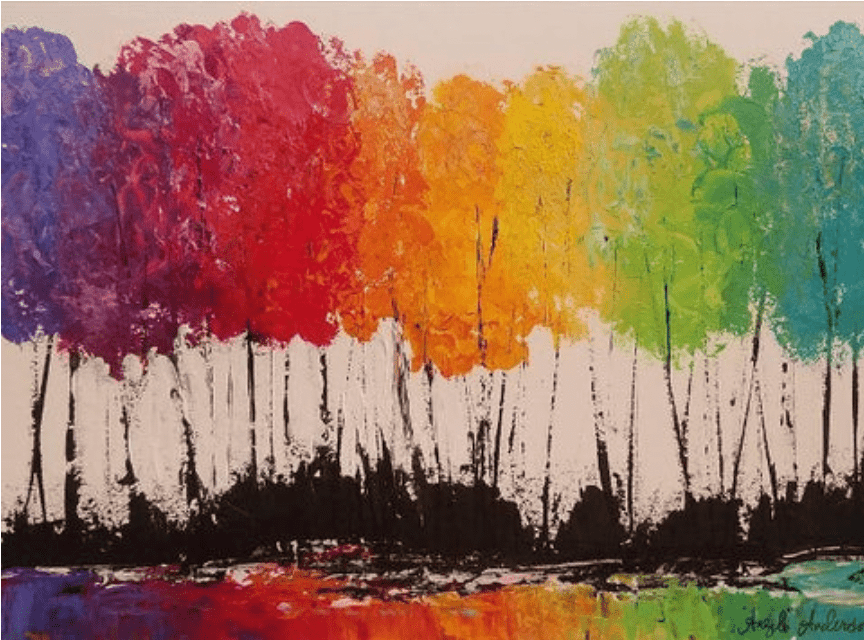
There's nothing more refreshing than a good change of colours in your sweet home! Although painting has its own difficulties and might be challenging if you never did it before, it's a great way to beautify and maintain your room.
There are numerous ways to paint a room, and most people struggle with deciding the best. Should you paint all the walls the same colour? Should you have an accent wall? How will the lighting affect the paint colour? Will your furniture and decorations go with the colour? Lots of details to consider for sure.
You don't need to worry. The Artchi prepared the best guide for you! If you want to learn how to paint your room or beautify it with an artistic mural, keep reading the post!
How to Paint Your Room
First Step: Do Your Planning

Like every other activity, painting also requires good planning. Begin with imagining how you want your room to look after painting. Make a list of colours and tones you like better to decide. If you know which colour you want to paint your room, it's time to decide on other details.
You should always pick the right shade. Whereas warm shades would help you create a colourful space, cool shades would give you a fresher one. The best way to see which shades would go better with your room is to get samples from brands to see which tone will compromise your furniture, paintings, and other art.
Don't be afraid to go creative! You don't have to paint all four walls of your room the same colour. You can always paint a wall in a bold shade to serve as an accent wall. Or, if you want to get even artier, you can leave one wall unpainted to create a magnificent mural!
Second Step: Buy the Equipment

After deciding the colour you want, you should choose which brand to buy paint. You always have to prefer quality paints, so have a quick Google search and see what people think about different paint brands. If you know someone who painted their house recently, you might get recommendations from them, too.
1. Decide How Much Paint You Need
Deciding how much paint you need to paint your room is always tricky. Although one gallon per 400 square feet is usually ideal, depending on the colour and texture of your room, you might need more. Since going from dark to light colours and working on textured surfaces often require more coats, it's best to buy more paint than "sufficient."
2. Buy Quality Tools
The quality of your tools will highly affect the result. If you don't have quality tools, your room will probably end up something different than what you wanted. For this reason, spending money on painting tools will never be money wasted. Some of the tools you'll need are:
- Paint roller (with an extension pole)
- Paintbrushes
- Paint tray
- Sandpaper
Third Step: Prepare the Walls and The Room

Before starting, you should always prepare the room. Take out as much furniture as possible, and remove the light switch and outlet covers. Painter tape would be another way to protect outlets and switches from paint drips. In short, just protect anything you don't want to be painted by removing or covering it.
If you don't have enough space in your house to move everything, gather all the objects in the centre of the room and use a drop cloth to cover them. Also, don't forget to cover the floor since the paint will definitely drip.
Fourth Step: Mix Your Paint

If you have prepared the room, it's time to mix your paint. Use a wooden paint stick to stir until it's ready. If you have more than one gallon of paint, chances are they have some tone differences. The best way to deal with this is to pour all the paint into one bucket and mix.
Fifth Step: Paint!

If you have done everything correctly until here, you're ready to paint your room, grab your paint brush! Be careful and try not to splash paint everywhere. It is always easier to paint from the top of the wall to the down; this way, there'll be fewer paint marks as well.
For painting a bold accent wall, you should begin with the light walls. Thus, even if the light paint gets in your accent wall, you can paint it away with a darker tone. If you want to cover a dark wall with a brighter shade, use three coatings: a primer and two coats of the new colour.
Turn Your Wall into Canvas: How to Make Murals?

If painting your wall isn't enough and you want to work your magic, you can always try to ornament your room with a classy mural! The only thing you need is some imagination and plenty of acrylic paints! If you don't know where to start, don't worry, The Artchi is here to help.
1. Choose the Best Paints

Although you can use other types of paints, too, acrylic paints are the best for murals. And, since creating the perfect mural requires the best equipment, you should choose a good brand that has quality paints.
2. Learn How to Mix Colours

Knowing the colours and their nature is significant. You should know how to mix different colours to expand your palette greatly. Also, since different mixes provide many possibilities, it's fun to explore different combinations of colours.
3. Find Ideas

You might already have something in your mind, but the question is: will it go with your wall? If you aren't sure, you can always explore mural ideas online to get inspiration. Plus, trying out different designs or scenes on a canvas before painting on your wall would help you get more creative ideas.
4. Get the Required Equipment

For painting a large mural, you can use the same equipment for painting a room. Yet, if you’re more into minimalistic designs, paintbrushes will also help. Since brushes differ in hardness and shape, you need to know the differences between them as well. Also, if your room has a high ceiling, you might want to use a ladder.
5. Let Your Creativity Do the Work

If you're ready, begin painting. Unleash the artist inside you and create the artiest mural, that will make all your guests stunned! The process might seem challenging, but once you successfully finish it, you'll also be amazed by the result.
6. Work Safe

Following the safety tips is a must. No matter what you do, always work safely. Don't eat anything with all those paints and other synthetic materials around. Also, be sure you know how to remove those acrylic paint stains since you shouldn't let them stay too long on your skin.







Leave a comment
All comments are moderated before being published.
This site is protected by hCaptcha and the hCaptcha Privacy Policy and Terms of Service apply.